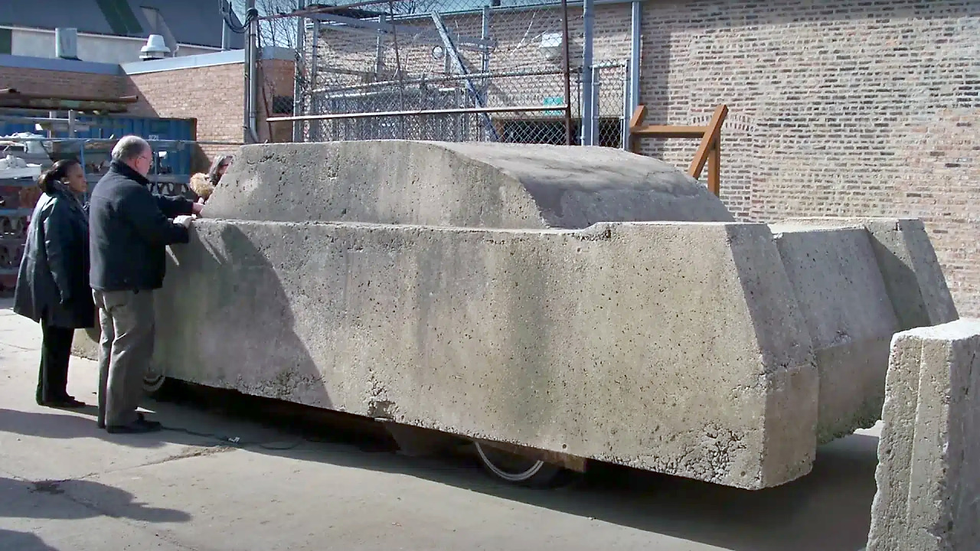1974 Ferrari CR 25 by Pininfarina
- Story Cars

- Feb 6, 2022
- 3 min read
Although Ferrari's four-seat models ranked among the firm's top sellers, Pininfarina's prancing horse-badged styling concepts were typically based on racier platforms that were better suited to dramatic coachwork.
This was especially true during the 1960s when Ferrari regularly sent Pininfarina competition chassis that had become surplus to requirements.
Throughout this period, Pininfarina was unveiling futuristic Ferrari-badged dream cars practically every year. However, the supply of suitable racing chassis quickly dried up following FIAT's 1969 acquisition of Ferrari, at which point the firm's sports car racing program was rationalized.
The CR 25 was presented at the Turin Motor Show in October 1974 and was the first Pininfarina-Ferrari concept since the Modulo of 1970. It arrived two years after the four-seat 365 GT4 was launched and previewed how a potential successor might look.
While the CR 25 could have taken Ferrari's four-seat line in a new stylistic direction, the Maranello firm stuck with its existing design. Through four different series, the 365 GT4 stayed in production until 1989, by which time it had evolved into the 412i.
The CR 25 was named in recognition of its 0.025 drag coefficient. The main brief demonstrated that an aerodynamically efficient design could still look exciting.
Pininfarina also explored innovative ways of adapting to increasingly stringent safety legislation. Lawmakers (particularly in the USA) were demanding bigger impact-absorbing bumpers proving difficult for designers to integrate elegantly.
Theoretically, the CR 25 could have run Ferrari's 4.4-liter V12 or even a Flat 12 motor. No engine was ever fitted, though, nor were any technical details proposed. The chassis shared an identical 2700mm wheelbase with the 365 GT4. The track was widened by 150mm at the front and 80mm at the rear.
The 365 GT4 tubular steel chassis that the CR 25 was most likely based upon was almost identical to 365 GTC/4, albeit with a 200mm wheelbase extension. The suspension was independent all-around with unequal-length wishbones and coil-sprung telescopic Koni shocks. A self-leveling rear axle was fitted along with power steering. Anti-roll bars were installed at both ends.
The quest for clean aerodynamics heavily influenced the new fastback body. To this end, considerable time was spent in Pininfarina's wind tunnel had built-in 1972. The CR 25 came with little ornamentation but did feature several innovations that were not immediately obvious.
For example, there were concealed touch-sensitive door catches, a front bumper that acted as a spoiler, and sail panels that housed pop-up air brakes.
The CR 25's livery comprised three sections. The upper body was painted pearlescent white. At its base, the louvered sill panels and the front and rear aprons were finished in brushed aluminum to match the dished wheel discs. Next, there was a thick satin black waistline to mask the bumpers.
The front bumper was designed to stabilize airflow over the car. It largely obscured the CR 25's dramatically drooped nose.
Retractable headlights were installed, each with a single rectangular lens. The lights were located below a full-width bank of body-colored radiator louvers. A set of auxiliary driving lights were housed underneath the bumper.
An integrated spoiler was formed at the back by a rear screen that sloped beneath the trailing edge of the connected C-pillars. An inverted tail housed two rows of full-width light clusters above the bumper. Overall, the CR 25 was 124mm wider and 130mm lower than the 365 GT4. It was also 10mm shorter despite a prodigious rear overhang.
Inside, Pininfarina opted for a typical seventies color combination. The bright blue fabric was used for the seats, door panels, and rear bulkhead. The beige carpet and natural alloy were used for much of the switchgear. The dash, transmission tunnel, seat frames, roof, pillars, and parcel shelf were upholstered in dark brown Alcantara.
A digital dash was connected to the transmission tunnel through a vertical central control panel that housed neat touch-sensitive controls instead of traditional levers and toggles. The kind of minimalist two-spoke steering wheel fitted was all the rage at the time. The vivid blue seats were six cushions and added to the futuristic ambiance. The cabin was extremely spacious, especially the rear quarters. A considerable glass area gave a light and airy feel.
After making its salon debut at the Turin Motor Show in October 1974, the CR 25 returned to Pininfarina's studio. Although Ferrari opted not to go down the CR 25 route for its V12-engined four-seat line, some of the styling details were later adopted on the Mondial, most notably the thick black bumper treatment. The upper body sections were then repainted silver, and the CR 25 was rolled out for another series of publicity photos. It has since faded into obscurity.
Source: Supercar Nostalgia
Images: Pininfarina; Concept Car Central; scanzen.tumblr.com








































































































Comments